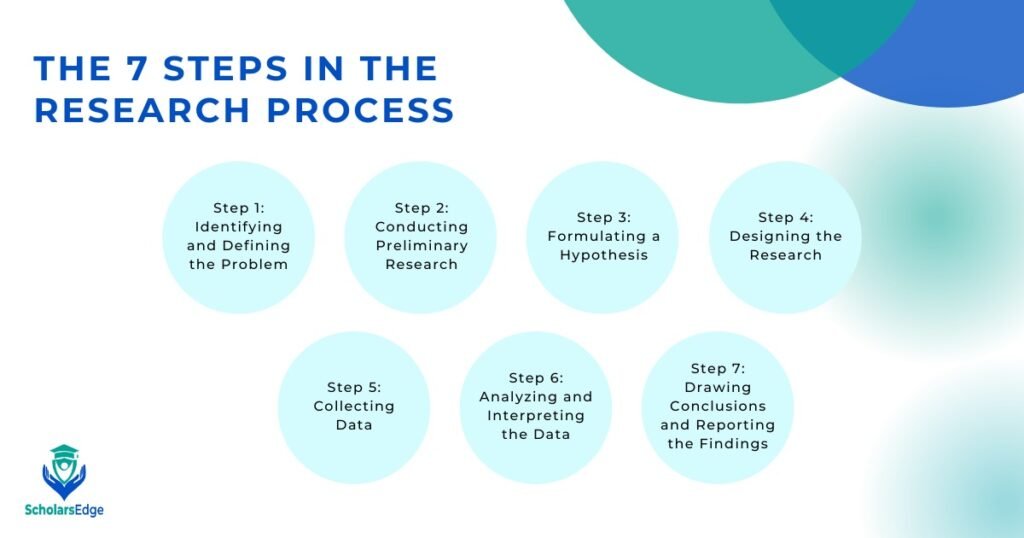
The research process is a structured approach to discovering new information or confirming existing knowledge. It involves several critical steps, each building on the last, to ensure the integrity and reliability of the findings.
In this comprehensive guide, we will explore the steps in the research process, delving into the commonly acknowledged 7 steps that form the backbone of any systematic investigation. Understanding these steps can significantly enhance the quality and effectiveness of research.
The Steps in the Research Process
Step 1: Identifying and Defining the Problem
Before you can start research, you must know what you want. The first step involves identifying the issues or questions that need to be answered. Researchers spend a considerable amount of time defining problems clearly and precisely. This involves asking questions such as the following:
- What is the nature of the problem?
- What are the key variables involved?
- Who or what will be affected by this research?
- This step sets the direction for the research process and ensures that the study remains focused and relevant.
Step 2: Conducting Preliminary Research
Once the problem is defined, the next step is to find out what is already known about the topic. This involves conducting preliminary research or a literature review. Researchers collect existing information related to the problem, which helps in:
- Understanding the background of the topic.
- Identifying theories and concepts already explored.
- Highlighting gaps in existing research.
This step helps to avoid reinventing the wheel and allows researchers to build on the foundation of existing knowledge.
Step 3: Formulating a Hypothesis
Based on the preliminary research, the next step is formulating a hypothesis – a statement that predicts the research outcome. A hypothesis is an educated guess about the relationships between variables and guides the research design and analysis. It should be:
- Clear and concise.
- Testable with the data and methods chosen.
- Based on existing theory and research.
A well-formulated hypothesis makes the research directional, providing a clear focus for data collection and analysis.
Step 4: Designing the Research
This step involves planning how to conduct the research in a way that achieves the objectives and tests the hypothesis. This includes deciding on:
- The research methodology (qualitative, quantitative, or mixed methods).
- The design of the study (experimental, correlational, survey, etc.).
- The sample size and sampling method.
- The tools and techniques for data collection (surveys, interviews, experiments, etc.).
- A robust research design is crucial for obtaining reliable and valid results.
Step 5: Collecting Data
With the design in place, researchers collect the data that will inform their study. This step is critical and must be done carefully to avoid bias and errors. Data collection can involve:
- Conducting experiments.
- Administering surveys or questionnaires.
- Performing observations.
- Reviewing records or existing databases.
The quality of the research findings heavily relies on the accuracy and integrity of the data collected.
Step 6: Analyzing and Interpreting the Data
After collecting the data, researchers analyse it to see if it supports or contradicts their hypothesis. This step involves using statistical tools and techniques to make sense of the data. Researchers need to:
- Process and organise the data for analysis.
- Use statistical methods to test the hypothesis.
- Interpret the results in the context of the research questions and the existing literature.
- This analysis helps to draw meaningful conclusions about the research question.
Step 7: Drawing Conclusions and Reporting the Findings
The final step in the research process is summarising the findings and drawing conclusions. This involves:
- Discuss how the results relate to the hypothesis and research questions.
- Considering the implications of the findings for theory, practice, and future research.
- Identify any limitations of the study and suggest areas for further research.
The results and conclusions are then compiled into a research report or paper, which should be structured to clearly and coherently present the research process and findings.

FAQs
What are the Research Process Outline and Steps?
The research process involves a systematic and structured approach to gathering, analysing, and interpreting data or information to address a research question or solve a particular problem. Here are the key steps in the research process:
Identify the Research Question or Problem
This is the initial step in defining the problem or question that your research aims to address. The research question should be specific, relevant, and focused on an area of interest.
Conduct a Literature Review:
After identifying the research question, review existing research and literature related to your topic. This helps identify gaps in knowledge and areas where further research is needed. A literature review also provides a theoretical framework for your study.
Formulate a Hypothesis or Research Objectives:
Based on the research question and literature review, create a hypothesis (a testable statement) or specific research objectives. Hypotheses can be tested for validity, while research objectives guide your study’s goals.
Design a Research Plan and Methodology:
Develop a research plan that outlines how you will collect and analyse data. Specify details such as sample size, data collection methods (surveys, interviews, observations, experiments), and data analysis techniques.
Collect and Analyze Data:
Implement your research plan by collecting relevant data. This step involves gathering information according to your chosen methodology. Once collected, clean and organise the data, apply statistical and analytical techniques, and interpret the results.
Interpret the Findings and Draw Conclusions:
Analyse the data to draw meaningful conclusions. Assess the validity and reliability of your results. Determine whether your hypothesis was supported or not. Consider any limitations of your research and discuss the implications of your findings.
Communicate the Results:
Share your research outcomes through a research report, presentation, or publication. The research report should include details about the research question, literature review, methodology, data analysis, findings, and conclusions. Additionally, it provides recommendations for further research in the area.
Remember that research is an iterative process; you may need to review and revise your approach as you progress.
What is the Final Step in the Research Process?
The final step in the research process involves communicating the results. Once you have analyzed the data, drawn conclusions, and assessed the validity of your findings, it’s essential to share your research outcomes with others. This step is crucial because it translates raw data into helpful information for further research and decision-making.
Which is a Step in the Research Process?
All the mentioned phases are steps in the research process. Each plays a vital role in ensuring the research is thorough, reliable, and valuable.
Conclusion
Understanding the steps in the research process is essential for conducting effective and meaningful research. By systematically following these steps, researchers can ensure their work is robust, reliable, and ready to contribute to the more significant body of knowledge. Remember, research is a journey; every step, from problem identification to reporting the findings, is a critical part of the adventure.
